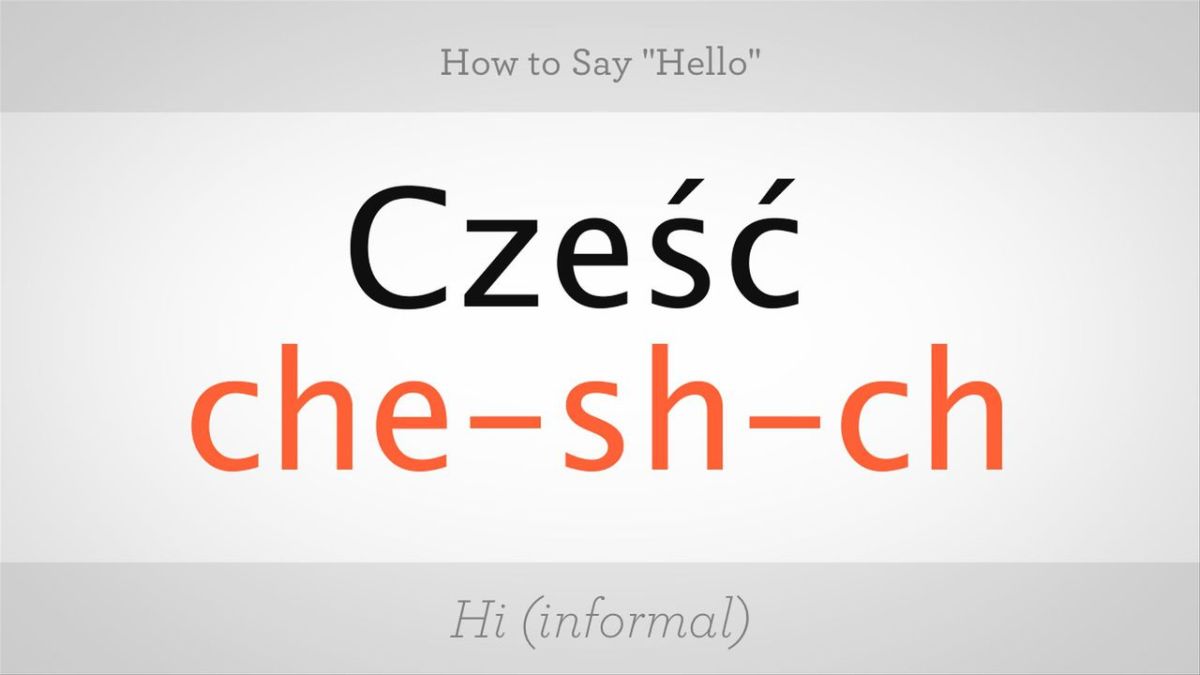Learn How To Say Hello In Polish: Formal & Informal Greetings
Want to make a genuine connection in Poland? Mastering the art of the Polish greeting is key. It's the first step towards building rapport, showing respect, and navigating the nuances of Polish social etiquette.
From the bustling streets of Warsaw to the quaint villages of the countryside, greetings in Poland are more than just perfunctory exchanges. They reflect a deep-rooted cultural emphasis on politeness and genuine human connection. Whether you're a seasoned traveler, a budding language enthusiast, or simply curious about Polish customs, understanding the diverse ways to say "hello" can enrich your interactions and leave a lasting positive impression.
| Category | Greeting | Pronunciation (Approximate) | Meaning/Usage |
|---|---|---|---|
| Informal | Cze | chesh-ch | Hi/Bye (Most common, versatile informal greeting) |
| Informal | Hej | hey | Hey (Similar to English "hey") |
| Informal | Siema | sheh-mah | What's up? (Very informal, mostly among youth) |
| Informal | Mio ci widzie | mee-woh cheh vee-dzyeh-ch | Nice to see you (More formal than "cze") |
| Informal | Pa pa | pah pah | Bye bye |
| Informal | Na razie | nah rah-zhee-eh | See you later |
| Informal | Do jutra | doh yoo-trah | See you tomorrow |
| Informal | Trzymaj si / Trzymajcie si | tchee-mye sieh / tchee-mye-cheh sieh | Take care (singular/plural) |
| Formal | Dzie dobry | jeyn DOH-bry | Good morning/Good day (Used until evening) |
| Formal | Dobry wieczr | DOH-bry VYEH-choor | Good evening |
| Formal | Witam | VEE-tahm | Welcome/Greetings (More formal, can be used in groups) |
| Formal | Witaj | VEE-tye | Welcome/Greetings (Singular, more personal than "witam") |
Learn More About Polish Greetings
The cornerstone of informal Polish greetings is "cze," a versatile word that serves as both "hi" and "bye." Its brevity and ubiquity make it the go-to greeting among friends, family, and even casual acquaintances. While "cze" reigns supreme, younger generations often opt for the equally informal "hej" or the slangy "siema," akin to "what's up?" For expressing genuine pleasure at seeing someone, "mio ci widzie" (nice to see you) adds a touch of warmth to the interaction. Departing calls for "pa pa," "na razie" (see you later), or the future-oriented "do jutra" (see you tomorrow). And to show you care, "trzymaj si" (singular) or "trzymajcie si" (plural) offer a heartfelt "take care."
Navigating formal greetings requires a touch more finesse. "Dzie dobry" (good morning/good day) is the standard formal greeting, used from morning until evening. As dusk settles, "dobry wieczr" (good evening) takes its place. For more official settings or when addressing a group, "witam" (welcome/greetings) conveys a respectful tone. Its singular counterpart, "witaj," adds a personal touch while maintaining formality. Choosing the appropriate formal greeting demonstrates respect for Polish customs and creates a positive first impression.
Beyond the basics, regional variations add a layer of linguistic richness to Polish greetings. While standard Polish is widely understood, local dialects often feature unique greetings that reflect the country's diverse heritage. Exploring these regional nuances can deepen your appreciation for the language and culture.
Mastering Polish greetings isn't just about memorizing phrases; it's about understanding the cultural context in which they're used. Polish people value politeness and genuine connection. A warm greeting, coupled with a smile and eye contact, can go a long way in establishing rapport and fostering meaningful interactions.
Whether you're ordering a pierogi at a local market or engaging in a business meeting, the right greeting sets the tone for a positive exchange. Embrace the opportunity to learn these linguistic building blocks and unlock a deeper understanding of Polish culture. From a simple "cze" to a heartfelt "dzie dobry," your efforts will be met with appreciation and open doors to genuine connection. So, take the plunge, practice your greetings, and embark on a journey of linguistic and cultural discovery in Poland.
The subtleties of Polish greetings extend beyond mere words. Intonation, body language, and even the firmness of a handshake play a role in conveying sincerity and respect. Observe how Polish speakers interact with each other and try to emulate their natural flow and demeanor. Don't be afraid to ask questions and seek clarification Polish people are generally patient and happy to help language learners.
Learning Polish greetings isnt merely a linguistic exercise; its a cultural immersion. It demonstrates a willingness to engage with the local culture on its own terms, which is invariably appreciated by Polish speakers. A friendly cze or a respectful dzie dobry can open doors to deeper connections and more meaningful experiences. Embrace the challenge, practice with enthusiasm, and watch as your efforts are rewarded with warm smiles and genuine Polish hospitality.



Detail Author:
- Name : Dulce Wunsch
- Username : sage48
- Email : maeve89@leffler.com
- Birthdate : 1983-04-27
- Address : 476 Garrick Square Trompbury, MN 57962
- Phone : +1 (743) 519-6991
- Company : Cronin PLC
- Job : Information Systems Manager
- Bio : Delectus velit vero deleniti ab ratione consequatur. Est est nihil quae aut nesciunt rerum eligendi. Fugiat repudiandae officia consequatur.
Socials
tiktok:
- url : https://tiktok.com/@corene_xx
- username : corene_xx
- bio : Sed fugit quia quasi officiis.
- followers : 2137
- following : 2126
instagram:
- url : https://instagram.com/corenemacejkovic
- username : corenemacejkovic
- bio : Ea deserunt laborum voluptates ut qui et et. Doloribus natus aut aut quasi. Quae qui non at sit.
- followers : 3647
- following : 2708